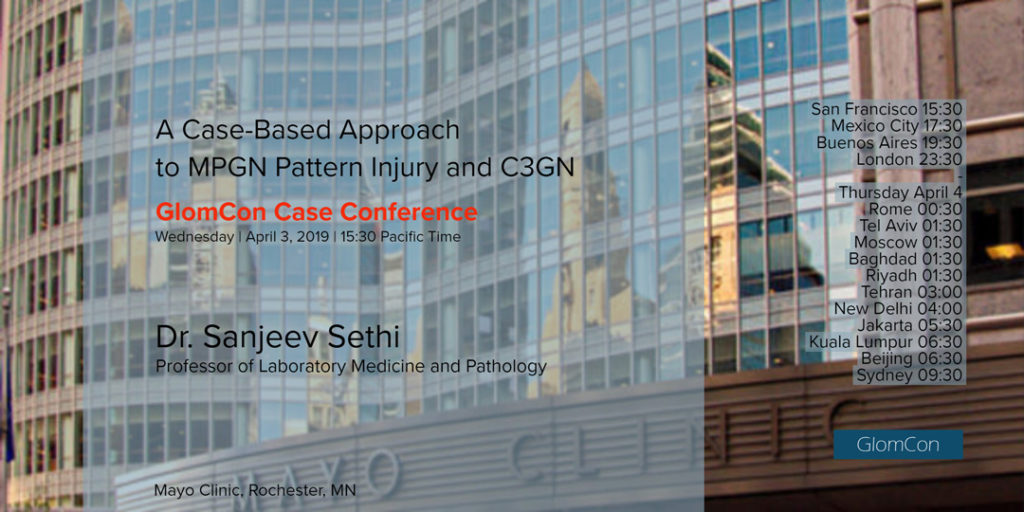NEPHROPATHOLOGY
A Case-Based Approach to MPGN Pattern of Injury and C3G
In this GlomCon Conference, Dr. Sanjeev Sethi shared his expertise with us and reviewed the pathology of MPGN pattern of injury and C3 Glomerulopathy. Our Moderator’s Notes* are derived from his live presentation.


By. Dr. Harpreet Singh
Key Points:
- Membranoproliferative Glomerulonephritis (MPGN) = a pattern of injury characterized by chronic deposition of Ig, complement, and/or fibrin along the glomerular capillary wall, leading to cycles of inflammation and repair
- LM: mesangial and endocapillary hypercellularity, mesangial expansion (often appears lobular), cellular interposition with double contour formation
- IF: varies depending on the nature of the deposits (see below)
- EM: mesangial/capillary wall (subendothelial) deposits, cellular interposition and new basement membrane formation leading to double contours.
- The old MPGN classification system (Type I, II, or III) was based on the deposit location by EM. Now, we classify MPGN based on deposit composition by IF .
- Ig +/- C3 suggests an Ig (including cryoglobulin) mediated process: think dysproteinemia, autoimmune disease, or infection
- Dominant C3 (staining 2 orders of magnitude greater than any other immune reactant) suggests a complement mediated process: think C3 glomerulopathy, which includes C3 Glomerulonephritis (C3GN) and Dense Deposit Disease (DDD)
- The underlying pathophysiology of C3 glomerulopathy involves dysregulation and overactivation of the alternative pathway of the complement system.
- E.g. loss of CFH inhibition (mutations in CFH or auto-antibodies to CFH), CFH deregulation (from altered CFHR proteins), autoantibodies that stabilize C3 convertase (C3 nephritic factor), or impaired inactivation of C3b.
- This results in overactivity of C3 convertase and then C5 convertase, with resulting deposition of complement proteins in the glomerulus.
- In a Mayo clinic cohort of patients with C3 glomerulopathy, three basic triggers were identified: monoclonal Ig (especially in DDD), infections, and autoimmune disease.
- Monoclongal Igs were more identified more frequently (~65%) in those older than 50. Pathogenic variants in complement protein genes were rare. These patients tended to do worse clinically.
- The underlying etiology of the monoclonal Ig included MGRS, myeloma, smoldering myeloma, CLL/lymphoma, and cryoglobulinemia.
- Treatment targeting monoclonal Ig resulted in remission/stabilization of kidney function in some patients. Hematologic remission was associated with renal remission in this patient subgroup.
- If there was no monoclonal immunoglobulin detected, 60% of patients had a genetic variant identified.
- Monoclongal Igs were more identified more frequently (~65%) in those older than 50. Pathogenic variants in complement protein genes were rare. These patients tended to do worse clinically.
- Mass spectrometry has been used to determine deposit composition in C3GN and DDD.
- Both C3 GN and DDD are characterized by large amounts of C3. Less C5-C9 was identified in DDD vs. C3 GN, suggesting a greater role for C5 convertase over activity (vs. C3 convertase over activity) in C3GN than in DDD.
- In both C3GN and DDD, C3dg was the predominant C3 cleavage product detected.
- Among Mayo clinic patients, there has been no significant difference in response to therapy between conservative vs. immunosuppressive (steroids, MMF, eculizumab, tacrolimus, rituximab) therapy. Approximately 50% reach ESRD at 5 years.
References:
https://www.ncbi.nlm.nih.gov/pubmed/17018561
https://www.ncbi.nlm.nih.gov/pubmed/22435371
https://www.ncbi.nlm.nih.gov/pubmed/25447133
https://www.ncbi.nlm.nih.gov/pubmed/26185203
https://www.ncbi.nlm.nih.gov/pubmed/22456601
https://www.ncbi.nlm.nih.gov/pubmed/23623956
https://www.ncbi.nlm.nih.gov/pubmed/24408117
